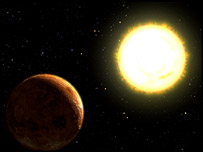About a third of the solar systems known today have a chance of containing an Earth-like star that has had, has or will have life
Avi Blizovsky and Nir Stav

How many Earth-like planets are there?
Nir Stav, a window to physics
In the last decade, astronomers have discovered evidence of planets around other stars, and not just around our sun. The form of discovery is usually based on slight fluctuations of these suns as a result of the gravitational force of the planets. The number of planets outside the solar system that have been discovered so far is about 130.
However, with the current detection methods, it was not possible to diagnose the existence of planets of modest dimensions, such as our Earth, since the force of attraction it exerts on the Sun is tiny. The planets that have been discovered are gigantic in size, the smallest of which has a mass similar to Neptune and most of them have a mass similar to that of Jupiter and exceeds it. In fact, it is possible that at least some of the massive representatives of these 'planets' are not planets but 'brown dwarfs'.
In addition, most of these planets are very close to their suns, in some cases they are in an orbit whose radius is smaller than that of the planet Mercury. The reason for this is probably a method
The measurement - since the force of gravity weakens with distance, only planets close to their sun can shake it to a significant degree.
In addition, distant planets complete a rotation cycle over many years and thus it is difficult to detect periodicity in the Sun's oscillation during a measurement lasting a few years.
As stargazers try to improve measurement techniques to detect smaller and more distant planets, researchers from the Open University of Milton tried to see if there might be Earth-like planets in the alien solar systems discovered so far.
For the news in Universe Today
A window site for physics
British astronomers: Many Earth-like planets await discovery
Avi Blizovsky
Researchers from the UK are convinced that many Earths are out there waiting to be discovered. The scientists say that about half of all known solar systems may also host inhabited worlds. "It must be said that most of these systems are strange places, where supergiant planets are close to their sun.
But Barry Jones and his colleagues say that the modeling work they have done suggests that even in these strange systems, there is room for small rocky planets.
An Open University team presented these findings as part of the UK's National Astronomy Week which convened on Tuesday. Recent studies and studies from the past "placed the issue as a basis for the model," Prof. Jones told the BBC. The researchers calculated the expected number of Earths considering what we know about the way planets are formed and the conditions necessary for life - especially the need to be in an area of the solar system where it is neither too hot nor too cold for liquid water.
disaster area
The conclusions have not changed, I am happy to say that almost half of the solar systems may contain Earths in the area suitable for life and that life has had enough time to develop" added Jones.
The limitations of today's telescope technology make it extremely difficult to observe exoplanets directly. Astronomers have to locate these planets indirectly - by finding stars that appear to be oscillating in their orbits due to the gravitational influence of large and nearby planets. The technique is biased in that it usually only looks at bizarre systems - where the planets have several Jupiter masses and orbit their sun in a similar orbit to that of Mercury.
This creates a problem because our current thinking holds that these giant Jupiters formed away from their star and migrated inward. And if they did, chances are they destroyed everything in their path, including errant Earths. "We don't have the ability to simply estimate the extent of these disaster areas," explains Prof. Jones.
Fortunately, even in the models developed by the members of his team, they found space and freedom for the development of Earth globes. Although the giant swallows all the dust in its path, enough remains to form into an earthly planet. The team estimates that about half of the systems have a safe place and there was also a sufficient period from the past to the present that life could develop on planets of this type.
The situation gets complicated because the habitable zone moves outward as the star ages, and in some cases, these changes pose a risk to the development of life. Thus the safe haven for life for some of these planets was in the past and for others it is expected in the future.
These scenarios of extinctions in the past and the birth of new life in the future reduce the selection of possible systems to two thirds of the known systems where there is a potential life area (ie half of the systems) or in other words - about a third of the systems.
The study by Barry Jones, Nick Sleep and David Underwood was published in the Astrophysical Journal.
For news on the BBC
